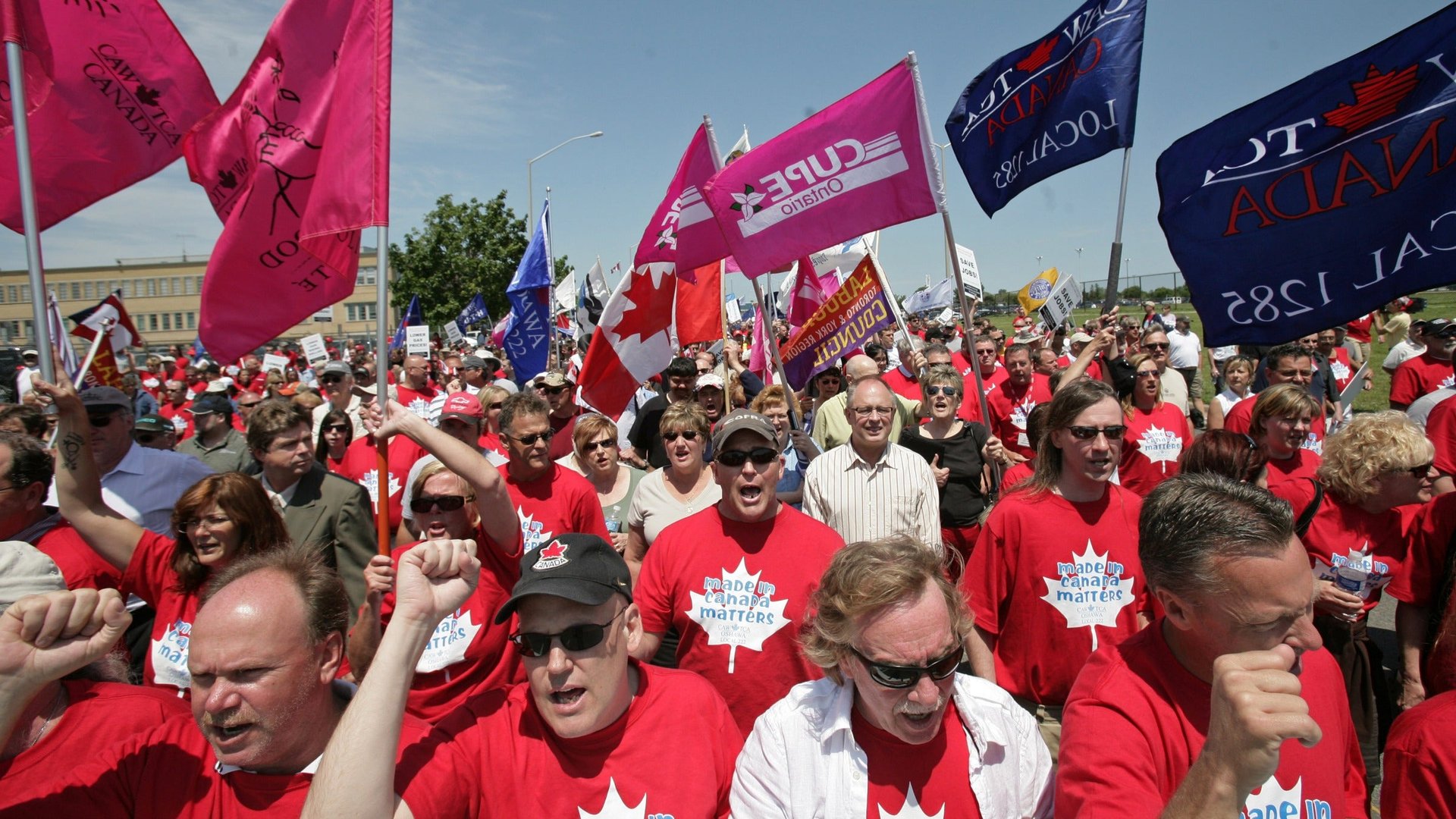Canada’s unions are getting bigger but aren’t necessarily stronger
Unions in Canada are trying to better flex their muscles by merging. The once mighty Canadian Auto Workers (CAW) and the Communications, Energy and Paperworkers (CEP) unions became partners last month, taking the name Unifor. The merger created the largest private sector union in the country with 300,000 members in 20 economic sectors and a projected budget of almost $100 million (pdf). Then, the United Steelworkers and the Telecommunications Workers Union announced they had tentatively agreed to a similar marriage.


Unions in Canada are trying to better flex their muscles by merging. The once mighty Canadian Auto Workers (CAW) and the Communications, Energy and Paperworkers (CEP) unions became partners last month, taking the name Unifor. The merger created the largest private sector union in the country with 300,000 members in 20 economic sectors and a projected budget of almost $100 million (pdf). Then, the United Steelworkers and the Telecommunications Workers Union announced they had tentatively agreed to a similar marriage.
Unifor president, Jerry Dias, says pooling resources is not just about being bigger, “the mindset is thinking quicker, mobilizing quicker.” Of course, bigger helps. In the 1970s, strong economic growth driven mainly by manufacturing, caused union membership to swell, as did the birth of the welfare state. Unions had significant influence and leverage. When they called on the general public to denounce high interest rates in 1981,100,000 people turned out at a protest on Parliament Hill, the seat of Canada’s government in Ottawa.
“It was huge at the time,” says Charlotte Yates, Dean of the Faculty of Social Sciences at McMaster University and a professor in the School of Labour Studies. “And the [manufacturing] plant occupations done by CAW, some of the fight backs by public sector unions garnered enormous support.” She adds that a number of government members were also sympathetic to their causes.
But all that changed. As multinational corporations flourished, trade unions began losing feathers. The Canadian economy shed more than half a million manufacturing jobs just in the last decade. Some argue that unions were further weakened by government, with Ottawa and the provinces introducing back-to-work legislation dozens of times since the 1980s. The current federal conservative government intervened on five occasions in 2011 and 2012 to prevent or end strikes by Air Canada, Canada Post and Canadian Pacific Railway workers, which, Yates says, tilted the balance of power in favor of corporations.
Globalization, recessions, and technological change have forced unions to soften their tone and agree to more concessions. Gone are the days of such acrimonious and violent conflicts as the 1974 United Aircraft strike that lasted 20 months and resulted in a dozen injuries and more than 30 arrests. That strikes have become less frequent and generally more civilized is good for both sides. However, companies have been making more gains than unions, who have been losing out on job security, finds recent study by Mélanie Laroche of the School of Industrial Relations, at Université de Montréal.
The latest recession hasn’t helped matters. Although there are signs of recovery, Dias argues that the situation has not started turning around for workers. In the last three decades, while Canada’s rich have been getting richer, a report indicates that middle-class families have only seen their after-tax income grow by 7%.
Strategic alliances such as Unifor’s are not new. There were 164 major American union mergers between 1956 and 2007. And in the last 12 years, “super unions” have formed across Europe, like Verdi in Germany and Unite in the UK. Recent talks of more mega union mergers in Britain have business leaders concerned and they would like the Competition Commission to look into the issue.
As large as the unions may become, Yates believes they don’t have an appetite for fierce fights because the odds of winning against large multinational corporations aren’t in their favor. In bridging what has traditionally been a divide along occupational lines, Unifor hopes to affect change through more than just collective bargaining. Its goal is to tackle some of those broader issues that affect members and non-members like the high cost of daycare. It has made a point of highlighting its mission by branding itself “a union for everyone.”